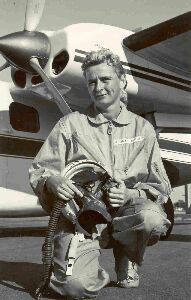
Features
 |
Features |
 White
House Resumes Shoot- White
House Resumes Shoot--downs |
|
| White
House resumes foreign "shoot down"
program; AOPA and IAOPA oppose shooting civilians by Richard Harris The White House announced August 19th it will resume the "Airbridge Denial Program" with Colombia, a U.S. drug - interdiction program helping foreign authorities shoot down civilian aircraft. This is the first of the "Airbridge" programs to resume after the bloody U.S.-arranged shoot-down of an innocent missionary family in Peru in 2001. The White House said that Colombia has "appropriate procedures to protect against loss of innocent life." But the Aircraft Owner's & Pilot's Association, and the International Council of Aircraft Owner & Pilot Associations, repeated their opposition to the use of deadly force against any civilian aircraft which do not threaten national security. "We support aggressive efforts to stop drug smuggling," says Phil Boyer, IAOPA and AOPA-US president, "but as was so tragically demonstrated in Peru, the risks of shooting down an innocent aircraft far outweigh the satisfaction of downing a drug smuggler. The same modern technology and superior intelligence information that makes it possible to identify a suspected aircraft in the first place could just as easily be used to track the aircraft to its landing point where officials could arrest the suspects." In the Peruvian disaster, April 2001, directed by a CIA-operated Citation surveillance jet, a Peruvian A-37 Dragonfly fighter jet fired on a Cessna 185 floatplane, after the U.S. surveillance jet said it might be a flight ferrying illegal drugs. But the plane was flown by Kevin Donaldson, a missionary for the U.S.-based Association of Baptists for World Evangelism. Donaldson was carrying fellow missionary Jim Bowers and his family to Iquito to get a visa for their infant daughter.... * * * According to AOPA's Washington office, a State Department insider says resumption of the Airbridge program with Peru is now also under consideration. Many members of Congress have expressed concern about resumption of the program.... For the REST
of the story, |
Extraordinary
Aero
Commander "Astronette" Aero Commander kept ahead with record flights of its own, or sponsoring those of others. In an age of "right stuff" men, like Chuck Yeager and Max Conrad, the most important Aero Commander record-setter would be a shy, petite young woman, with a passion for flight: Jerrie Cobb. Born Geraldyn M. Cobb, in Oklahoma in 1931, "Jerrie" knew by the age of six she would make her life in the sky. At 12, she rode in her father's WACO biplane, and began learning to fly. Experience and ratings came quickly: Private at 16 and barnstorming a Cub (sleeping under the wings between stops); Commercial ticket at 18, but with a horde of ex-WWII male pilots around, no one would hire her, except for crummy or hazardous jobs like cropdusting and pipeline patrol - which she took, anyway, as she built her ratings -- all the way to an Airline Transport Rating. Whatever it takes to fly At 19 she was instructing (her CFI rating came two years later) and she finally found steady work in the hazardous work of ferry pilot - ferrying war-surplus trainers, transports, bombers and fighters to other countries -- on long flights over mountains, jungles, and shark-infested oceans. Latin American governments showered her with awards for outstanding service and pioneering new air routes over largely uncharted jungles and mountains. Her boyfriend -- a ferry pilot, too -- did not survive the hazardous missions. But Jerrie persisted. She flew B-17's to Europe, and became the first woman to fly in the world's oldest airshow, the Paris Air Show. She was awarded the Amelia Earhart Gold Medal of Achievement in 1949. Back home in Oklahoma, she tried to get hired at Oklahoma City's Aero Design (original manufacturers of the Aero Commander), who would not hire a female pilot. So she got the state to sponsor her attempts at a few world records.... * * * By now, the shy pilot had become a national celebrity, featured in the leading magazines of the day. The National Pilots' Association named her 1959 Pilot of the Year. "Astronette" As NASA began preparing the "Mercury 7" astronauts, it secretly decided to put a few women through the same rigorous tests. Cobb was their first subject, and outscored many of the men, even on grueling physical tests. With thousands more hours of flight experience than even John Glenn, she showed she had the "right stuff." On that basis, NASA let her help pick a dozen other women candidates, who became known as the "Mercury 13." Most did well on the testing, while Jerrie and another candidate moved ahead to astronaut training.... For more information, contact the Jerrie Cobb Foundation, Inc. For the REST
of the story, |
for reprint rights, contact In Flight USA.

